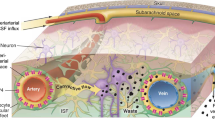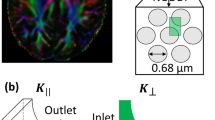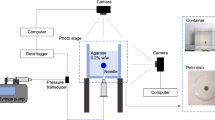Abstract
Convection-enhanced delivery (CED) is a promising local delivery technique for overcoming the blood–brain barrier (BBB) and treating diseases of the central nervous system (CNS). For CED, therapeutics are infused directly into brain tissue and the drug agent is spread through the extracellular space, considered to be highly tortuous porous media. In this study, 3D computational models developed using magnetic resonance (MR) diffusion tensor imaging data sets were used to predict CED transport in the rat ventral hippocampus using a voxelized modeling previously developed by our group. Predicted albumin tracer distributions were compared with MR-measured distributions from in vivo CED in the ventral hippocampus up to 10 μL of Gd-DTPA albumin tracer infusion. Predicted and measured tissue distribution volumes and distribution patterns after 5 and 10 μL infusions were found to be comparable. Tracers were found to occupy the underlying landmark structures with preferential transport found in regions with less fluid resistance such as the molecular layer of the dentate gyrus. Also, tracer spread was bounded by high fluid resistance layers such as the granular cell layer and pyramidal cell layer of dentate gyrus. Leakage of tracers into adjacent CSF spaces was observed towards the end of infusions.








Similar content being viewed by others
References
Abbott, N. J. Evidence for bulk flow of brain interstitial fluid: significance for physiology and pathology. Neurochem. Int. 45(4):545–552, 2004.
Astary, G. W., S. Kantorovich, P. R. Carney, T. H. Mareci, and M. Sarntinoranont. Regional convection-enhanced delivery of gadolinium-labeled albumin in the rat hippocampus in vivo. J. Neurosci. Methods 187(1):129–137, 2010.
Basser, P. J., and D. K. Jones. Diffusion-tensor MRI: theory, experimental design and data analysis—a technical review. NMR Biomed. 15(7–8):456–467, 2002.
Bennewitz, M. F., and W. M. Saltzman. Nanotechnology for delivery of drugs to the brain for epilepsy. Neurotherapeutics 6(2):323–336, 2009.
Bertram, E. H. Functional anatomy of spontaneous seizures in a rat model of limbic epilepsy. Epilepsia 38(1):95–105, 1997.
Bobo, R. H., D. W. Laske, A. Akbasak, P. F. Morrison, R. L. Dedrick, and E. H. Oldfield. Convection-enhanced delivery of macromolecules in the brain. PNAS 91(6):2076–2080, 1994.
Brady, M., R. Raghavan, Z. J. Chen, and W. C. Broaddus. Quantifying fluid infusions and tissue expansion in brain. IEEE Trans. Biomed. Eng. 58(8):626–632, 2011.
Chen, M. Y., A. Hoffer, P. E. Morrison, J. F. Hamilton, J. Hughes, K. S. Schlageter, J. Lee, B. R. Kelly, and E. H. Oldfield. Surface properties, more than size, limiting convective distribution of virus-sized particles and viruses in the central nervous system. J. Neurosurg. 103(2):311–319, 2005.
Chen, M. Y., R. R. Lonser, P. F. Morrison, L. S. Governale, and E. H. Oldfield. Variables affecting convection-enhanced delivery to the striatum: a systematic examination of rate of infusion, cannula size, infusate concentration, and tissue-cannula sealing time. J. Neurosurg. 90(2):315–320, 1999.
Chen, X. M., G. W. Astary, H. Sepulveda, T. H. Mareci, and M. Sarntinoranont. Quantitative assessment of macromolecular concentration during direct infusion into an agarose hydrogel phantom using contrast-enhanced MRI. Magn. Reson. Imaging 26(10):1433–1441, 2008.
Chen, X. M., and M. Sarntinoranont. Biphasic finite element model of solute transport for direct infusion into nervous tissue. Ann. Biomed. Eng. 35(12):2145–2158, 2007.
Conturo, T. E., N. F. Lori, T. S. Cull, E. Akbudak, A. Z. Snyder, J. S. Shimony, R. C. McKinstry, H. Burton, and M. E. Raichle. Tracking neuronal fiber pathways in the living human brain. PNAS 96(18):10422–10427, 1999.
Foley, C. P., N. Nishimura, K. B. Neeves, C. B. Schaffer, and W. L. Olbricht. Real-time imaging of perivascular transport of nanoparticles during convection enhanced delivery in the rat cortex. Ann. Biomed. Eng. 40(2):292–303, 2011.
Geer, C. P., and S. A. Grossman. Interstitial fluid flow along white matter tracts: a potentially important mechanism for the dissemination of primary brain tumors. J. Neurooncol. 32(3):193–201, 1997.
Good, C. D., I. S. Johnsrude, J. Ashburner, R. N. A. Henson, K. J. Friston, and R. S. J. Frackowiak. A voxel-based morphometric study of ageing in 465 normal adult human brains. Neuroimage 14(1):21–36, 2001.
Harbaugh, R. E. Novel CNS-directed drug delivery systems in Alzheimers-disease and other neurological disorders. Neurobiol. Aging 10(5):623–629, 1989.
Hrabetova, S. Extracellular diffusion is fast and isotropic in the stratum radiatum of hippocampal ca1 region in rat brain slices. Hippocampus 15(4):441–450, 2005.
Jagannathan, J., S. Walbridge, J. A. Butman, E. H. Oldfield, and R. R. Lonser. Effect of ependymal and pial surfaces on convection-enhanced delivery. Laboratory investigation. J. Neurosurg. 109(3):547–552, 2008.
Jain, R. K. Delivery of novel therapeutic agents in tumors-physiological barriers and strategies. J. Natl Cancer Inst. 81(8):570–576, 1989.
Johansen-Berg, H., and T. E. J. Behrens. Diffusion MRI. London, UK: Academic Press, 2009.
Kim, J. H., G. W. Astary, X. Chen, T. H. Mareci, and M. Sarntinoranont. Voxelized model of interstitial transport in the rat spinal cord following direct infusion into white matter. J. Biomech. Eng. 131(7):071007-1–071007-8, 2009.
Kim, J. H., G. Astary, S. Kantorovich, T. H. Mareci, P. R. Carney, and M. Sarntinoranont. Measurement of in vivo tracer distribution during CED in the rat brain using DCE-MRI. In: 37th Annual Meeting and Exposition of the Controlled Release Society, Portland, OR, July 10–14, 2010.
Kim, J. H., T. H. Mareci, and M. Sarntinoranont. A voxelized model of direct infusion into the corpus callosum and hippocampus of the rat brain: Model development and parameter analysis. Med. Biol. Eng. Comput. 48(3):203–214, 2010.
Krauze, M. T., T. R. McKnight, Y. Yamashita, J. Bringas, C. O. Noble, R. Saito, K. Geletneky, J. Forsayeth, M. S. Berger, P. Jackson, J. W. Park, and K. S. Bankiewicz. Real-time visualization and characterization of liposomal delivery into the monkey brain by magnetic resonance imaging. Brain Res. Protoc. 16(1–3):20–26, 2005.
Krauze, M. T., R. Saito, C. Noble, J. Bringas, J. Forsayeth, T. R. McKnight, J. Park, and K. S. Bankiewicz. Effects of the perivascular space on convection-enhanced delivery of liposomes in primate putamen. Exp. Neurol. 196(1):104–111, 2005.
Linninger, A. A., M. R. Somayaji, M. Mekarski, and L. B. Zhang. Prediction of convection-enhanced drug delivery to the human brain. J. Theor. Biol. 250(1):125–138, 2008.
Linninger, A. A., M. R. Somayaji, L. B. Zhang, M. S. Hariharan, and R. D. Penn. Rigorous mathematical modeling techniques for optimal delivery of macromolecules to the brain. IEEE Trans. Biomed. Eng. 55(9):2303–2313, 2008.
Lonser, R. R., S. Walbridge, K. Garmestani, J. A. Butman, H. A. Walters, A. O. Vortmeyer, P. F. Morrison, M. W. Brechbiel, and E. H. Oldfield. Successful and safe perfusion of the primate brainstem: in vivo magnetic resonance imaging of macromolecular distribution during infusion. J. Neurosurg. 97(4):905–913, 2002.
Morrison, P. F., M. Y. Chen, R. S. Chadwick, R. R. Lonser, and E. H. Oldfield. Focal delivery during direct infusion to brain: role of flow rate, catheter diameter, and tissue mechanics. Am. J. Physiol. Regul. Integr. Comp. Physiol. 277(4):R1218–R1229, 1999.
Murad, G. J. A., S. Walbridge, P. F. Morrison, K. Garmestani, J. W. Degen, M. W. Brechbiel, E. H. Oldfield, and R. R. Lonser. Real-time, image-guided, convection-enhanced delivery of interleukin 13 bound to pseudomonas exotoxin. Clin. Cancer Res. 12(10):3145–3151, 2006.
Neeves, K. B., C. T. Lo, C. P. Foley, W. M. Saltzman, and W. L. Olbricht. Fabrication and characterization of microfluidic probes for convection enhanced drug delivery. J. Controlled Release 111(3):252–262, 2006.
Nicholson, C., and E. Syková. Extracellular space structure revealed by diffusion analysis. Trends Neurosci. 21:207–215, 1998.
Nilsen, K. E., and H. R. Cock. Focal treatment for refractory epilepsy: hope for the future? Brain Res. Rev. 44(2–3):141–153, 2004.
Paxinos, G., and C. Watson. The Rat Brain in Stereotaxic Coordinate (4th ed.). San Diego, CA: Academy Press, 1998.
Prabhu, S. S., W. C. Broaddus, G. T. Gillies, W. G. Loudon, Z. J. Chen, and B. Smith. Distribution of macromolecular dyes in brain using positive pressure infusion: a model for direct controlled delivery of therapeutic agents. Surg. Neurol. 50(4):367–375, 1998.
Prokopova, S., L. Vargova, and E. Sykova. Heterogeneous and anisotropic diffusion in the developing rat spinal cord. NeuroReport 8(16):3527–3532, 1997.
Raghavan, R., M. L. Brady, M. I. Rodriguez-Ponce, A. Hartlep, C. Pedain, and J. H. Sampson. Convection-enhanced delivery of therapeutics for brain disease, and its optimization. Neurosurg. Focus 20(4):E12, 2006.
Raghavan, R., S. Mikaelian, M. Brady, and Z.-J. Chen. Fluid infusions from catheters into elastic tissue: I. Azimuthally symmetric backflow in homogeneous media. Phys. Med. Biol. 55(1):281–304, 2010.
Saito, R., M. T. Krauze, C. O. Noble, M. Tamas, D. C. Drummond, D. B. Kirpotin, M. S. Berger, J. W. Park, and K. S. Bankiewicz. Tissue affinity of the infusate affects the distribution volume during convection-enhanced delivery into rodent brains: implications for local drug delivery. J. Neurosci. Methods 154(1–2):225–232, 2006.
Sampson, J. H., R. Raghavan, M. L. Brady, J. M. Provenzale, J. E. Herndon, D. Croteau, A. H. Friedman, D. A. Reardon, R. E. Coleman, T. Wong, D. D. Bigner, I. Pastan, M. I. Rodriguez-Ponce, P. Tanner, R. Puri, and C. Pedain. Clinical utility of a patient-specific algorithm for simulating intracerebral drug infusions. Neuro-Oncology 9(3):343–353, 2007.
Sarntinoranont, M., R. K. Banerjee, R. R. Lonser, and P. F. Morrison. A computational model of direct interstitial infusion of macromolecules into the spinal cord. Ann. Biomed. Eng. 31(4):448–461, 2003.
Sarntinoranont, M., X. M. Chen, J. B. Zhao, and T. H. Mareci. Computational model of interstitial transport in the spinal cord using diffusion tensor imaging. Ann. Biomed. Eng. 34(8):1304–1321, 2006.
Schulz, G., H. J. A. Crooijmans, M. Germann, K. Scheffler, M. Muller-Gerbl, and B. Muller. Threedimensional strain fields in human brain resulting from formalin fixation. J. Neurosci. Methods 202:17–27, 2011.
Shepherd, T. M., P. E. Thelwall, G. J. Stanisz, and S. J. Blackband. Aldehyde fixative solutions alter the water relaxation and diffusion properties of nervous tissue. Magn. Reson. Med. 62(1):26–34, 2009.
Smith, J. H., and J. J. Garcia. A nonlinear biphasic model of flow-controlled infusions in brain: mass transport analyses. J. Biomech. 44(3):524–531, 2011.
Støverud, K. H., M. Darcis, R. Helmig, and S. M. Hassanizadeh. Modeling concentration distribution and deformation during convection-enhanced drug delivery into brain tissue. Transp. Porous Media 92(1):119–143, 2012.
Sykova, E., and C. Nicholson. Diffusion in brain extracellular space. Physiol. Rev. 88(4):1277–1340, 2008.
Tao, L., and C. Nicholson. Diffusion of albumins in rat cortical slices and relevance to volume transmission. Neuroscience 75(3):839–847, 1996.
White, E., A. Bienemann, J. Malone, L. Megraw, C. Bunnun, M. Wyatt, and S. Gill. An evaluation of the relationships between catheter design and tissue mechanics in achieving high-flow convection-enhanced delivery. J. Neurosci. Methods 199(1):87–97, 2011.
Wood, J. D., R. R. Lonser, N. Gogate, P. F. Morrison, and E. H. Oldfield. Convective delivery of macromolecules into the naive and traumatized spinal cords of rats. J. Neurosurg. 90(1):115–120, 1999.
Yushkevich, P. A., J. Piven, H. C. Hazlett, R. G. Smith, S. Ho, J. C. Gee, and G. Gerig. User-guided 3d active contour segmentation of anatomical structures: significantly improved efficiency and reliability. Neuroimage 31(3):1116–1128, 2006.
Zhang, Y., and W. M. Pardridge. Delivery of beta-galactosidase to mouse brain via the blood-brain barrier transferrin receptor. J. Pharmacol. Exp. Ther. 313(3):1075–1081, 2005.
Acknowledgments
We would like to thank Drs. Mansi Parekh and Rabia Zafar for providing valuable scientific discussions. We would also like to thank Wei Dai for help with the manuscript. The project described was supported by award number R01NS063360 from the National Institute of Neurological Disorders and Strokes. The content is solely the responsibility of the authors and does not necessarily represent the official views of the National Institute Neurological Disorders and Strokes or the National Institutes of Health. The MRI data were obtained at the Advanced Magnetic Resonance Imaging and Spectroscopy (AMRIS) facility in the McKnight Brain Institute at the University of Florida.
Author information
Authors and Affiliations
Corresponding author
Additional information
Associate Editor K. A. Athanasiou oversaw the review of this article.
Rights and permissions
About this article
Cite this article
Kim, J.H., Astary, G.W., Kantorovich, S. et al. Voxelized Computational Model for Convection-Enhanced Delivery in the Rat Ventral Hippocampus: Comparison with In Vivo MR Experimental Studies. Ann Biomed Eng 40, 2043–2058 (2012). https://doi.org/10.1007/s10439-012-0566-8
Received:
Accepted:
Published:
Issue Date:
DOI: https://doi.org/10.1007/s10439-012-0566-8




